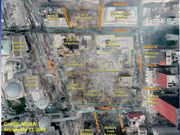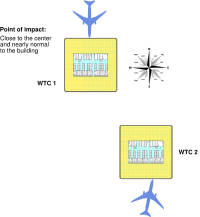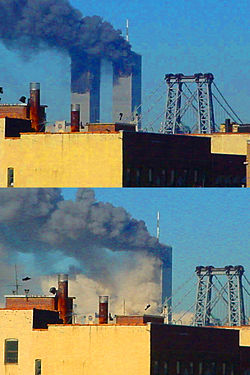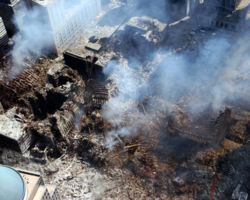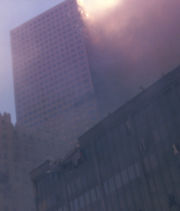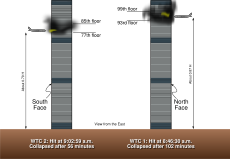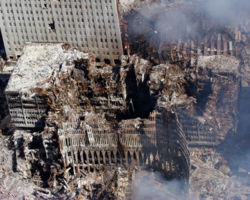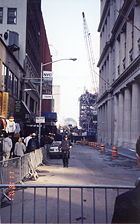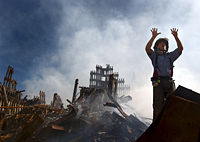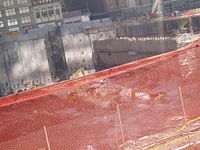Collapse of the World Trade Centre
2008/9 Schools Wikipedia Selection. Related subjects: Recent History
| Sept. 11, 2001 attacks |
|---|
| Timeline |
| Planning |
| September 11, 2001 |
| Rest of September |
| October |
| Beyond October |
| Victims |
| Survivors |
| Foreign casualties |
| Hijacked airliners |
| American Airlines Flight 11 |
| United Airlines Flight 175 |
| American Airlines Flight 77 |
| United Airlines Flight 93 |
| Sites of destruction |
| World Trade Centre |
| The Pentagon |
| Shanksville, Pennsylvania |
| Effects and aftermath |
| Airport security |
| Audiovisual entertainment |
| Closings and cancellations |
| Conspiracy theories |
| Detentions |
| Economic effects |
| Impact on popular culture |
| Reactions |
| Local health |
| Post 9/11 |
| Response |
| US Military response |
| US Government response |
| Rescue and recovery effort |
| Financial assistance |
| Operation Yellow Ribbon |
| Memorials and services |
| Perpetrators |
| Responsibility |
| Organizers |
| Miscellaneous |
| Communication |
| WTC collapse |
| Slogans and terms |
| Patriot Day |
| Inquiries |
| U.S. Congressional Inquiry |
| 9/11 Commission Report |
| PENTTBOM Inquiry |
The collapse of the World Trade Centre was the central event of the September 11, 2001 attacks, during which each of the twin towers was hit by a hijacked airliner. The south tower (2 WTC) collapsed at 9:59 a.m., less than an hour after being hit. The north tower (1 WTC) followed at 10:28 a.m.
2,751 people inside and near the towers were killed, including all 157 passengers and crew aboard the two airplanes. The collapse of the twin towers also caused extensive damage to the rest of the complex and nearby buildings. As a result, at 5:20 p.m. 7 World Trade Centre collapsed as well.
The Federal Emergency Management Agency (FEMA) completed its performance study of the buildings in May 2002. It declared the WTC design sound and attributed the collapses wholly to extraordinary factors beyond the control of the builders. While calling for further study, FEMA suggested that the collapses were probably initiated by weakening of the floor joists by the fires that resulted from the aircraft impacts. According to FEMA's report – and subsequently contradicted by NIST's findings – the floors detached from the main structure of the building and fell onto each other, initiating a progressive "pancake" collapse.
FEMA's proposed explanation was rejected by a later, more detailed investigation by the National Institute of Standards and Technology (NIST), which was completed in September 2005. Like FEMA, NIST vindicated the design of the WTC, noting that the severity of the attacks and the magnitude of the destruction was beyond anything experienced in U.S. cities in the past. NIST also emphasized the role of the fires, but it did not attribute the collapses to failing floor joists. Instead, NIST found that sagging floors pulled inward on the perimeter columns: "This led to the inward bowing of the perimeter columns and failure of the south face of WTC 1 and the east face of WTC 2, initiating the collapse of each of the towers."
The cleanup of the site involved round-the-clock operations, many contractors and sub-contractors, and cost hundreds of millions of dollars. The demolition of the surrounding damaged buildings continued even as new construction proceeded on the World Trade Centre's replacement, the Freedom Tower. Of the destroyed buildings, only 7 World Trade Centre has been replaced as of 2008.
Design
Architect Minoru Yamasaki designed the towers as framed tube structures, which provided tenants with open floor plans, uninterrupted by columns or walls. This was accomplished using numerous, closely-spaced perimeter columns to provide much of the strength to the structure, along with gravity load shared with the core columns. Above the seventh floor there were 59 perimeter columns along each face of the building and there were 47 heavier columns in the core. All of the elevators and stairwells were located in the core, leaving a large column-free space between the perimeter that was bridged by prefabricated floor trusses.
The floors consisted of 4 inch (10 cm) thick lightweight concrete slabs laid on a fluted steel deck. A grid of lightweight bridging trusses and main trusses supported the floors. The trusses had a span of 60 feet (18.2 m) in the long-span areas and 35 feet (11 m) in the short span area. The trusses connected to the perimeter at alternate columns, and were therefore on 6 foot 8 inch (2.03 m) centers. The top chords of the trusses were bolted to seats welded to the spandrels on the exterior side and a channel welded to the core columns on the interior side. The floors were connected to the perimeter spandrel plates with viscoelastic dampers, which helped reduce the amount of sway felt by building occupants. The trusses supported a 4 inch thick (10 cm) lightweight concrete floor slab, with shear connections for composite action.
The towers also incorporated a "hat truss" or "outrigger truss" located between the 107th and 110th floors, which consisted of six trusses along the long axis of core and four along the short axis. This truss system allowed some load redistribution between the perimeter and core columns and supported the transmission tower. It was found to play a key role in the collapse sequence.
The designers had considered the effects of the impact of a passenger jet, and believed the structures would remain standing in such an event. But NIST found reason to believe that they lacked the ability to properly model the effect of such impacts on the structures, especially the effects of the fires. (For more, see history.)
Impacts of airliners
Hijackers flew two Boeing 767 jet airliners, American Airlines Flight 11 (a 767-200ER) and United Airlines Flight 175 (a 767-200) into the towers. 1 WTC was hit at 8:46 a.m. by Flight 11 between the 99th and 93rd floors. 2 WTC was hit at 9:03 a.m. by Flight 175 between the 85th and 77th floor.
A Boeing 767-200 is 48.5 m (160 ft) long and has a wingspan of 48 m (156 ft), with a capacity of up to 62.2 (-200) or 91 (-200ER) m³ of jet fuel (16,700 or 24,000 US gallons). The planes hit the towers at very high speeds. Flight 11 was traveling roughly 700 km/h (440 mph) when it crashed into the 1 WTC, the north tower; flight 175 hit 2 WTC, the south tower, at about 870 km/h (540 mph). In addition to severing a number of load-bearing columns, the resulting explosions in each tower ignited 38 m³ (10,000 gallons) of jet fuel and immediately spread the fire to several different floors while consuming paper, furniture, carpeting, computers, books, walls, framing, and other items in all the affected floors. The force of the explosion from the initial impact in 1 WTC traveled through at least one express elevator shaft all the way down to the lobby floor, blowing out all of the windows and leaving a number of people injured.
The fires
The light construction and hollow nature of the structures allowed the jet fuel to penetrate far inside the towers, igniting many large fires simultaneously over a wide area of the impacted floors. The fuel from the planes burned at most for a few minutes, but the contents of the buildings burned over the next hour or hour and a half. It has been suggested that the fires might not have been as centrally positioned, nor as intense, had traditionally heavy high-rise construction been standing in the way of the aircraft. Debris and fuel would likely have remained mostly outside the buildings or concentrated in more peripheral areas away from the building cores, which would then not have become unique failure points. In this scenario, the towers might have stood far longer, perhaps indefinitely. The fires were hot enough to weaken the columns and cause floors to sag, pulling perimeter columns inward and reducing their ability to support the mass of the building above.
Deteriorating conditions
Calls from occupants trapped in the upper floors relayed information via 9-1-1 about conditions. At 9:37 a.m., an occupant on the 105th floor of the South tower reported that floors beneath him "in the 90-something floor" had collapsed. Deteriorating conditions were also reported by the helicopters of the NYPD aviation unit.
- 9:52 a.m. - the NYPD aviation unit reported over the radio that "large pieces may be falling from the top of WTC 2. Large pieces are hanging up there"
- 9:59 a.m. - they report that the South Tower is coming down.
NYPD helicopters report deteriorating conditions of the North Tower.
- 10:20 a.m. - the NYPD aviation unit reports that the top of the tower might be leaning.
- 10:21 a.m. - they report that the North Tower is buckling on the southwest corner and leaning to the south.
- 10:27 a.m. - the aviation unit reports that the roof is going to come down very shortly.
- 10:28 a.m. - the NYPD reports that the tower is collapsing.
With dispatchers overwhelmed, there was minimal communication with the NYPD, and the FDNY were experiencing problems with faulty radios. Firefighters inside the towers did not hear the evacuation order from their supervisors on the scene. 343 firefighters died in the Twin Towers, as a result of the collapse of the buildings.
Collapse of the twin towers
At 9:59 a.m., the south tower collapsed, 56 minutes after being struck. The north tower, struck at 8:46 a.m., collapsed at 10:28 a.m., 102 minutes after impact. The collapses produced enormous clouds of dust that covered Manhattan for days. In both cases, the commonly accepted process is that the damaged portion of the buildings failed, which allowed the section above the airplane impacts to fall onto the remaining structure below. Both buildings collapsed symmetrically and more or less straight down, though there was some tilting of the tops of the towers and a significant amount of fallout to the sides. As the collapse progressed, dust and debris could be seen shooting out of the windows several floors below the advancing destruction.
The collapse mechanism
Owing to differences in the initial impacts, the collapses of the two towers were found to differ in some respects, but in both cases, the same sequence of events applies. After the impacts had severed exterior columns and damaged core columns, the loads on these columns were redistributed. The hat trusses at the top of each building played a significant role in this redistribution of the loads in the structure.
The impacts also dislodged some of the fireproofing from the steel, increasing its exposure to the heat of the fires. In the 102 minutes before the collapse of 1 WTC, the fires reached temperatures that, although well below the melting point, were high enough to weaken the core columns so that they underwent plastic deformation and creep from the weight of higher floors. The NIST report provides a useful model of the situation.
| “ | At this point, the core of WTC 1 could be imagined to be in three sections. There was a bottom section below the impact floors that could be thought of as a strong, rigid box, structurally undamaged and at almost normal temperature. There was a top section above the impact and fire floors that was also a heavy, rigid box. In the middle was the third section, partially damaged by the aircraft and weakened by heat from the fires. The core of the top section tried to move downward, but was held up by the hat truss. The hat truss, in turn redistributed the load to the perimeter columns. (p. 29) | ” |
The situation was similar in 2 WTC. In both towers, perimeter columns and floors were also weakened by the heat of the fires, causing the floors to sag and exerting an inward force on exterior walls of the building.
At 9:59 a.m., 56 minutes after impact, the sagging floors finally caused the eastern face of 2 WTC to buckle, transferring its loads back to the failing core through the hat truss and initiating the collapse; the section above the impact area then tilted in the direction of the failed wall. At 10:28 a.m., 102 minutes after the impact, the south wall of 1 WTC buckled, with similar consequences. After collapse ensued, the total collapse of the towers was inevitable due to the enormous weight of the towers above the impact areas.
A combination of three factors allowed the north tower to remain standing longer, the region of impact was higher (so the gravity load on the most damaged area was lighter), the speed of the plane was lower (so there was less impact damage), and the affected floors had received partially upgraded fire proofing.
Total progressive collapse
Analysis of video footage capturing the initial collapse and analysis of seismic data from Palisades, New York shows that the first fragments of the outer walls of the collapsed north tower struck the ground 9 seconds after the collapse started, and parts of the south tower after 11 seconds. The cores of the buildings began to fall 15 to 25 seconds after the initial start of the collapse. These times are approximate because dust obscured the view.
The NIST report analyzes the failure mechanism in detail. An early analysis explains that the kinetic energy of the upper portion of the building falling onto the story below exceeded by an order of magnitude the amount of energy that the lower story could absorb, crushing it and adding to the kinetic energy. This scenario repeated with each successive story, crushing the entire tower at near free-fall speed.
Collapse of 7 World Trade Centre
The WTC complex comprised seven buildings, three of which completely collapsed on the day of the attacks. At 5:20 p.m., 7 World Trade Centre, a 47-story steel-frame skyscraper across the street from the rest of the complex, became the third building to collapse. Unlike the Twin Towers, the collapse of 7 WTC had been anticipated for several hours and the building had been evacuated. A transit (or theodolite) was used to measure the extent of a visible bulge.
FEMA's provisional study was inconclusive and the collapse of 7 WTC was not included in the final report of the NIST investigation into the collapse of the World Trade Centre when it was published in September 2005. With the exception of a letter to the Journal of Metallurgy, which suggested that some of the structural steel had been exposed to temperatures sufficient to melt it, no studies of the collapse of 7 WTC have been published in scientific journals.
NIST released a progress report in June 2004 outlining its working hypothesis. On this hypothesis a local failure in a critical column, caused by damage from either fire or falling debris from the collapses of the two towers, progressed first vertically and then horizontally to result in "a disproportionate collapse of the entire structure". Though it is not considering a controlled demolition hypothesis, NIST is developing hypothetical blast scenarios that could have caused the buildings structure to fail. It anticipates the release of a draft report of 7 World Trade Centre in 2008.
History of investigations
Initial reaction
The collapse of the World Trade Centre came as a surprise to engineers. "Before 9/11," wrote the New Civil Engineer, "it had been genuinely inconceivable that structures of such magnitude could succumb to this fate." While the initial damage from the airplanes was severe, it was localized to a few floors of each tower. The challenge for engineers was to explain how local damage could result in the complete progressive collapse of three of the biggest buildings in the world. Interviewed by the BBC in October 2001, the British architect Bob Halvorson correctly predicted that there would be "a debate about whether or not the World Trade Centre Towers should have collapsed in the way that they did." The autopsy would involve careful analysis of the plans of the WTC, its construction, eye witness testimony, video of the collapses, and examination of the wreckage. Emphasizing the difficulty of the task, Halvorson said that the collapses were "well beyond realistic experience."
Authority
Immediately following the collapses, there was some confusion about who had the authority to carry out an official investigation. While there are clear procedures for the investigation of aircraft accidents, no agency had been appointed in advance to investigate building collapses. A team was quickly assembled by the Structural Engineers Institute of the American Society of Civil Engineers. It also involved the American Institute of Steel Construction, the American Concrete Institute, the National Fire Protection Association, and the Society of Fire Protection Engineers. ASCE ultimately invited FEMA to join the investigation, which was completed under the auspices of the latter.
The investigation was criticized by some engineers and lawmakers in the U.S. It had little funding, no authority to demand evidence, and limited access to the WTC site. One major point of contention at the time was that the cleanup of the WTC site was resulting in the destruction of the majority of the buildings' steel components. Indeed, when NIST published its final report, it noted "the scarcity of physical evidence" that it had had at its disposal to investigate the collapses. Only a fraction of a percent of the buildings remained for analysis after the cleanup was completed: some 236 individual pieces of steel.
FEMA published its report in May 2002. While NIST had already announced its intention to investigate the collapses in August of the same year, by September 11, 2002 (a year after the disaster), there was growing public pressure for a more thorough investigation. Congress passed the National Construction Safety Team bill in October 2002. This provided the authority for the NIST investigation, which published its results in September 2005.
Design analysis
One question that investigators tried to answer was whether the buildings had been designed to survive events like those on 9/11. The WTC towers were, of course, designed to survive foreseeable fires and, while "no building code in the United States has specific design requirements for impact of aircraft", the scenario was considered by the structural engineers. NIST, however, found it difficult to document how the buildings were designed to anticipate aircraft impact.
Two accounts of the designers' anticipation of aircraft impact have been suggested in the course of the investigations. FEMA described the modeled aircraft as weighing 263,000 lb (119 metric tons) with a flight speed of 180 mph (290 km/h), both of which were exceeded in the actual impacts of 9/11. This description follows Leslie Robertson's remarks in the days immediately following the collapses. Robertson, who had participated in the structural design of the towers, recalled he "addressed the question of an airplane collision, if only to satisfy his engineer's curiosity". NIST was unable to document this reported study; Robertson could not find a copy and it was not an official study done by the WTC engineers. Journalists investigating the issue were also unable to find anyone to verify Robertson's recollection.
NIST did find a three page white paper from 1964 summarizing an extensive WTC structural study that included the effects of a Boeing 707 weighing 336,000 lb (152 metric tons) and carrying 23,000 US gallons (87 m³) of fuel impacting the 80th floor of the buildings at 600 mph (1,000 km/h). While this suggests planes that were faster than those that crashed into the towers on 9/11, the study found that the buildings would not collapse on such a scenario. This study is more in line with remarks made by John Skilling's after the 1993 bombing. When asked about this study by The New York Times Magazine, Robertson insisted that he had no knowledge of this study and that it had not actually been carried out.
It is unclear whether the effect of jet fuel and aircraft contents was a consideration in the original building design. "One view," writes NIST, "suggests that an analysis was done indicating the biggest problem would be the fact that all the fuel would dump into the building and there would be a horrendous fire. Another view suggests that the fuel load, and the fire damage that it would cause, may not have been considered." Without the original calculations, which were used to render its conclusions, NIST said, any further comment would amount to speculation.
FEMA's pancake collapse theory
FEMA developed an early explanation of the collapses, which had come to be known as the "pancake" theory. It was defended by Thomas Eagar and popularized by PBS. According to this explanation, when the connections between the floor trusses and the columns broke, the floors fell down one on top of the other, quickly exceeding the load that any one floor was designed to carry. A number of self-published accounts by structural engineers suggested that a combination of factors led to the collapse, but most suggested a version of pancake collapse.
As in the theory which is currently accepted, the fires were taken to be the key to the collapses. Thomas Eagar, an MIT materials professor, had described the fires as "the most misunderstood part of the WTC collapse". This is because the fires were originally said to have "melted" the floors and columns. As Eagar said, "The temperature of the fire at the WTC was not unusual, and it was most definitely not capable of melting steel." Jet fuel is essentially kerosene and would have served mainly to ignite very large, but not unusually hot, hydrocarbon fires. This led Eagar, FEMA and others to focus on what appeared to be the weakest point of the structures, namely, the points at which the floors were attached to the building frame. Once these connections failed, the pancake collapse could initiate. The NIST report, however, would ultimately vindicate the floor connections; indeed, the collapse mechanism depends on the strength of these connections as the floors pulled the outer walls in.
Early column failure theories
NIST's column failure theory had already been articulated, not least by Bažant and Zhou. MIT civil engineers Oral Buyukozturk and Franz-Josef Ulm, probably following Bažant's early proposal, also described a collapse mechanism on September 21, 2001.
They would later contribute to an MIT collection of papers on the WTC collapses edited by Eduardo Kausel called The Towers Lost and Beyond, published in May 2002.
The NIST report
Design of the study
After the FEMA report had been published, and following pressure from technical experts, industry leaders and families of victims, the Commerce Department's National Institute of Standards and Technology conducted a three-year, $24 million investigation into the structural failure and progressive collapse of several WTC complex structures. The study included in-house technical expertise and drew upon the knowledge of several outside private institutions for aid to include:
-
- Structural Engineering Institute of the American Society of Civil Engineers
- Society of Fire Protection Engineers
- National Fire Protection Association
- American Institute of Steel Construction
- Council on Tall Buildings and Urban Habitat
- Structural Engineers Association of New York
Scope and limits
The scope of the NIST investigation was limited to "the sequence of events from the instant of aircraft impact to the initiation of collapse for each tower" and "includes little analysis of the structural behaviour of the tower after the conditions for collapse initiation were reached and collapse became inevitable." In line with the concerns of most engineers, NIST focused on the airplane impacts and the spread and effects of the fires, modeling these at a very high level of detail. NIST developed several highly detailed structural models for specific sub-systems such as the floor trusses as well as a global model of the towers as a whole which is less detailed. These models are static or quasi-static, including deformation but not the motion of structural elements after rupture as would dynamic models. So, the NIST models are useful for determining how the collapse was triggered, but do not shed light on events after that point.
Ongoing investigations
In 2003, three engineers at the University of Edinburgh published a paper in which they provisionally concluded that the fires alone (without any damage from the airplanes) could have been enough to bring down the WTC buildings. In their view, the towers were uniquely vulnerable to the effects of large fires on several floors at the same time. When the NIST report was published, Barbara Lane, with the UK engineering firm Arup, criticized its conclusion that the structural damage resulting from the airplane impacts was a necessary factor in causing the collapses. Jose L Torero from the BRE Centre for Fire Safety Engineering at the University of Edinburgh is pursuing further research into the potentially catastrophic effects of fire on real-scale buildings.
Criticism
James Quintiere, professor of fire protection engineering at the University of Maryland, called the spoliation of the steel "a gross error" that NIST should have openly criticized. He also noted that the report lacked a timeline and physical evidence to support its conclusions.
Some engineers have suggested that our understanding of the collapse mechanism could be improved by developing an animated sequence of the collapses based on a global dynamic model, and comparing it with the video evidence of the actual collapses. In October 2005, the New Civil Engineer reported criticism of NIST's computer modelling. Colin Bailey at the University of Manchester and Rober Plank at the University of Sheffield called on NIST to produce computer visualizations of the collapses in order to correlate the collapse models with observed events.
Remarks by Osama bin Laden
Although its translation is contested, a videotape of Osama bin Laden verified by the Pentagon indicates that Bin Laden did not believe that the buildings would collapse completely, but only those levels above where the planes struck:
| “ | We calculated in advance the number of casualties from the enemy, who would be killed based on the position of the tower. We calculated that the floors that would be hit would be three or four floors. I was the most optimistic of them all. (...Inaudible...) Due to my experience in this field, I was thinking that the fire from the gas in the plane would melt the iron structure of the building and collapse the area where the plane hit and all the floors above it only. This is all that we had hoped for. | ” |
Other buildings
The entire WTC complex was destroyed on September 11, 2001, and many of the surrounding buildings were also either damaged or destroyed as the towers fell. 5 WTC suffered a large fire and a partial collapse of its steel structure.
Other buildings destroyed include St. Nicholas Greek Orthodox Church, Marriott World Trade Centre (Marriott Hotel 3 WTC), South Plaza (4 WTC), and U.S. Customs (6 WTC). The World Financial Centre buildings, 90 West Street, and 130 Cedar Street suffered fires. The Deutsche Bank Building, Verizon, and World Financial Centre 3 suffered impact damage from the towers' collapse, as did 90 West Street. One Liberty Plaza survived structurally intact but sustained surface damage including shattered windows. 30 West Broadway was damaged by the collapse of 7 WTC. The Deutsche Bank Building, which was covered in a large black "shroud" after September 11 to cover the building's damage, is currently being deconstructed because of water, mold, and other severe damage caused by the neighboring towers' collapse.
Aftermath
Site cleanup
The colossal pile of debris left on the site burned for three months, resisting attempts to extinguish the blaze until the majority of the rubble was finally removed from the site. The cleanup was a massive operation coordinated by the City of New York Department of Design and Construction (DDC).
On September 22, a preliminary cleanup plan was delivered by Controlled Demolition Inc. (CDI) of Phoenix. Mark Loizeaux, president of CDI, emphasized the importance of protecting the slurry wall (or " the bathtub") which kept the Hudson river from flooding the WTC's basement. It involved round-the-clock operations, many contractors and sub-contractors, and cost hundreds of millions of dollars. By early November, with a third of the debris removed, officials began to reduce the number of firefighters and police officers assigned to recovering the remains of victims, in order to prioritize the removal of debris. This caused confrontations with firefighters. In 2007, the demolition of the surrounding damaged buildings was still ongoing, even as new construction proceeded on the World Trade Centre's replacement, the Freedom Tower.
Air quality and the EPA's response
On September 18, 2001, the Environmental Protection Agency issued a statement assuring the public that the air in Manhattan was "safe to breathe". In a report published in 2003, however, the EPA's inspector general found that the agency did not at that time have sufficient data to make such a statement. Also, it found that the White House had influenced the EPA to remove cautionary statements and include assuring ones, in part motivated by the desire to reopen Wall Street. In fact, the collapse of the World Trade Centre resulted in serious reductions in air quality and is likely the cause of many respiratory illnesses among first responders, residents, and office workers in lower Manhattan.
Controlled demolition conspiracy theories
According to a 2006 poll, 16 percent of American adults believed that the World Trade Centre may have been destroyed by controlled demolition, not by the effects of the airplanes. This idea has been rejected by NIST, which concluded that there were no explosives or controlled demolition involved in the collapses of the WTC towers. Controlled demolition is also dismissed in the engineering literature and is pursued mainly as part of larger conspiracy theories about the events of 9/11.
